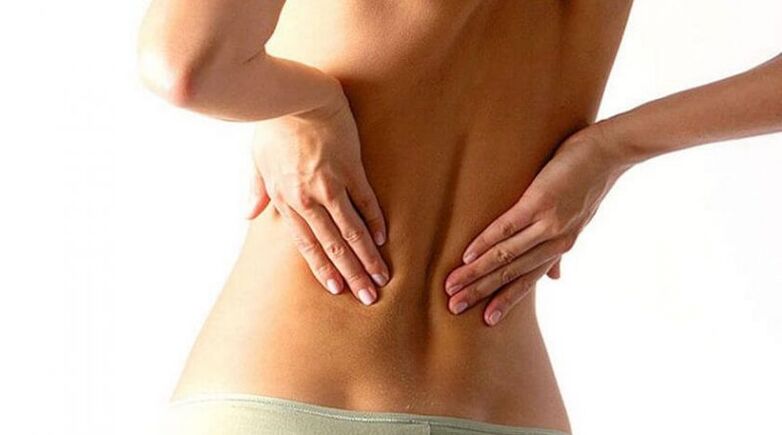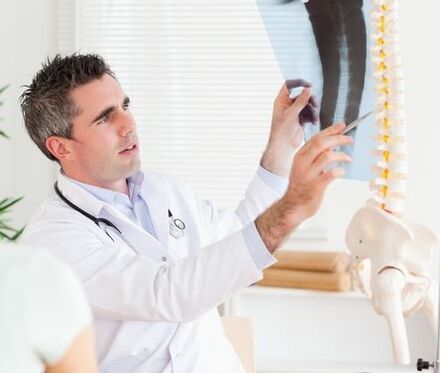
Spinal osteochondrosis is a disease that affects the cartilaginous structures that form the intervertebral discs of the human body. These discs ensure the mobility of the spine, giving us the opportunity to move and be flexible.
Osteochondrosis alters the structure of these discs, their structure changes. Since the process of destruction of these discs is irreversible, it is impossible to cure the disease. But with appropriate treatment you can stop the development of the disease, slow it down and gain time during which spinal mobility will be preserved.
If the disease is not stopped in time, after the destruction of the intervertebral discs, the destruction of the vertebrae begins.
Important!Ignoring osteochondrosis inevitably leads to complications, a forced decrease in physical activity, a deterioration in quality of life, and sometimes even disability.
Among the complications of osteochondrosis, one of the most common is osteophyte. This is the name of the bony growths that appear along the edges of the vertebrae. The appearance of such a growth can be provoked by prolonged stress on the spine or an unstable spinal motion segment.
Causes and symptoms of osteochondrosis.
Experts cite improper distribution of load on the spine as the main reason provoking the development of osteochondrosis.
However, the process can also be triggered by hypothermia of a certain part of the body or the entire organism, too much physical tension on the back in general and the spine in particular, as well as spinal injuries (spinal blows, twists sudden movements, shocks and any physical impact that could cause displacement of the vertebrae).

There are a large number of minor causes of osteochondrosis. Typically, a person who has had such a diagnosis can identify from this list between 7 and 10 reasons that triggered the development of the disease in their particular case.
So, listed below are minor but important reasons that cause the destruction of intervertebral discs. This is something you should avoid to avoid discovering what osteochondrosis is:
- bending over and poor posture (cause curvature of the spine)
- weak back muscles (because of this, the entire load falls on the spine)
- constantly being in an uncomfortable position
- Excessive physical activity associated with lifting and carrying heavy objects, strength sports.
- spinal injuries
- lack of nutrition or excess nutrition, which causes metabolic disorders.
- overweight
- sitting constantly
- stress
- hormonal disorders
- bad inheritance
- aging
As you can see, there are quite a few reasons. The symptoms of this disease are also varied. Osteochondrosis manifests itself differently in different people, but usually the following symptoms are observed during osteochondrosis:
- severe back pain
- numbness in the arms or legs (sometimes both at the same time)
- headaches that turn into migraines
- pain and discomfort in the neck and extremities
- dizziness, colored spots in front of the eyes, sometimes loss of consciousness
- cold hands and feet
- Characteristic pain in the chest (as in intercostal neuralgia) and in the heart area.
- painful movements
The appearance of osteochondrosis.
Interesting: some doctors believe that osteochondrosis is not a pathology, but a natural change in the human body.

One way or another, it is difficult to find a long-liver who has never suffered from back pain in his life. According to various sources, osteochondrosis affects 40 to 80% of all people on the planet.
Typically, a person notices the first signs of osteochondrosis between the ages of 35 and 50. This has a lot to do with his lifestyle.
And if in some people, due to bad heredity, the first symptoms appear in adolescence, for the majority, symptoms that appear after 50 years of age are considered the norm.
This is because at the age of 45 the human body stops accumulating water in the intervertebral discs and the level of collagen necessary for joint health inevitably begins to decrease.
In some people, the intervertebral discs may even become squeezed. This causes pain and is called sciatica.
Stages of osteochondrosis
There are 4 main stages in the development of osteochondrosis.
- It all starts with the fact that the nucleus pulposus suffers from dehydration. The annulus fibrosus becomes covered with cracks because the height of the intervertebral disc decreases. At this stage, the pathology is difficult to notice, since all changes occur in the intervertebral disc. I still don't have back or neck pain.
- As the height of the intervertebral disc decreases, sagging of the muscles and ligaments occurs. This is due to the convergence of the attachment points of muscles and ligaments. Initially, they are attached to two adjacent vertebrae, but if the distance between these vertebrae decreases, this cannot but affect the muscle tissue.
- The third stage is characterized by the fact that the changes become pronounced. Prolapses occur, as well as a phenomenon such as disc protrusion. The protrusion precedes the appearance of an intervertebral disc herniation. As a rule, at this stage the development of the disease can be stopped, becausethe annulus fibrosus is still intact and attempts can still be made to restore it. But due to the fact that the bump does not cause pain, few people seek help from a doctor at this stage.
- In the last stage, the annulus fibrosus ruptures. To counteract the excessive mobility of the vertebrae at the site of the destruction of the disc, the body mobilizes and osteophytes appear on the vertebrae.
Diagnosis
Before starting treatment for osteochondrosis, it is necessary to make a diagnosis and identify at what stage the disease is developing.
Important!Diagnosis of osteochondrosis is impossible without first taking a history.
If you notice any symptoms of osteochondrosis, listen carefully to your body.

The more you tell the doctor about your feelings, the faster and more accurately he will be able to make a diagnosis and begin the correct treatment. Do not think that there will be too much information: ask your family members if they have had manifestations of this disease. Family history will help more accurately determine the cause of osteochondrosis.
After the doctor finishes collecting your medical history and concludes from your complaints that this is most likely osteochondrosis, he will suggest that you undergo an X-ray examination.
If for some reason this type of exam is not right for you, your doctor may also suggest an MRI or CT scan. However, these examinations are not mandatory under the compulsory health insurance program, so you will have to pay for them yourself. Consider its high cost.
As a last resort, myelography is used to diagnose osteochondrosis. This is a painful and dangerous procedure in which the doctor injects a dye directly into the spinal canal.
How is osteochondrosis treated?
Currently, the treatment of osteochondrosis is practiced in many clinics. Some procedures give a positive effect, while others only relieve pain. If you decide on one of the treatment methods, before starting treatment for osteochondrosis, discuss this method with your doctor.
The most popular procedures now are:
- magnetic puncture effect
- pharmacopuncture effect
- needle reflexology
- void effect
- electrical stimulation
- manual therapy
Many of these procedures are not a treatment for osteochondrosis, but rather a treatment for some of the symptoms of osteochondrosis. That is why the doctor must coordinate the procedures. This is especially true for those patients who have been diagnosed with cervical osteochondrosis.
The fact is that osteochondrosis that has developed in the cervical spine is characterized by symptoms such as numbness of the arms and legs. And this is not a coincidence. The fact is that it is in the neck area where many nerve endings are concentrated. And incorrectly selected treatment in this case can turn your cervical osteochondrosis into total disability.
Surgical treatment
Spine surgery is such a serious task that it is prescribed with great caution and only if osteochondrosis is complicated by a herniated disc. These operations are not urgent, they are always carried out as planned. Before the operation, it will be necessary to undergo a large number of examinations and take many tests.
These operations are prescribed only if the doctor sees no other way out of treatment and realizes that without surgery the person's quality of life will significantly deteriorate. Before surgery, doctors will try to provide pain relief and supportive care.
Drugs
Medications to treat this condition are primarily designed to reduce pain and increase collagen levels in the body.

However, it is worth remembering that collagen and other nutrients from cartilage are absorbed not only by the spine, but throughout the body. Therefore, the effectiveness of these drugs is not very high.
The ointments that doctors recommend using for osteochondrosis are also primarily intended to relieve pain during an exacerbation.
Unfortunately, if you suffer from osteochondrosis, you will most likely need maintenance therapy for the rest of your life. That is, from time to time your back will hurt, you will not be able to exert yourself too much physically, above all you will have to avoid lifting heavy objects, which put pressure on your back and spine.
Exacerbation of osteochondrosis.
Exacerbations of this disease can occur due to high physical effort on the back muscles. In addition, osteochondrosis can be worsened by colds or infections, hypothermia, stress, pregnancy and hormonal changes. Weight gain will also cause back pain.
Prevention
As a preventive measure, doctors offer many patients physical exercises designed specifically for those who suffer from this disease.

If your doctor has prescribed an exercise treatment, you should check with him exactly which exercises are allowed for you. The exercises will help you keep your muscle corset in good shape and this will reduce the load on the spine. In addition, these exercises will be of great help for those who lead a sedentary lifestyle.
Also, for preventive purposes, you may be prescribed a massage. Depending on which part of the spine you have developed osteochondrosis, the masseuse will work in this area. This will not only relieve pain, but will also help relax your muscles. In combination with exercise therapy, massage produces good results.
Try to avoid strain on the spine, do not lift heavy objects. If possible, dress well, because. . . any hypothermia can provoke an exacerbation of osteochondrosis.
Living a full life with this disease is quite possible, don't forget to take care of your body and yourself.


























